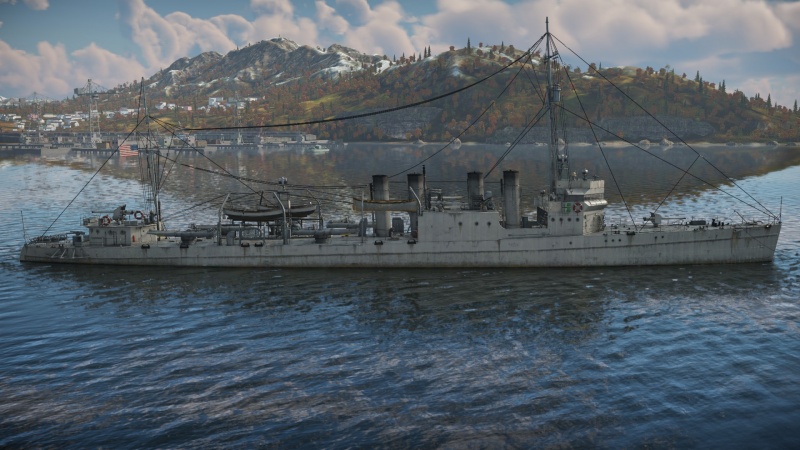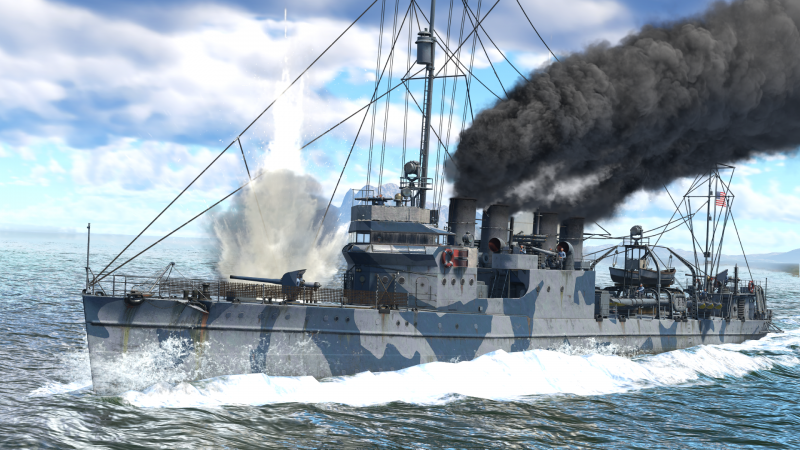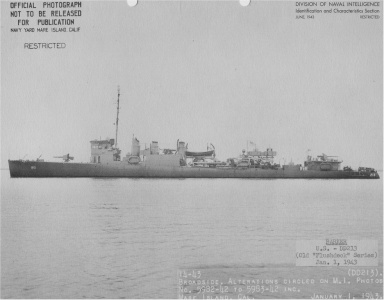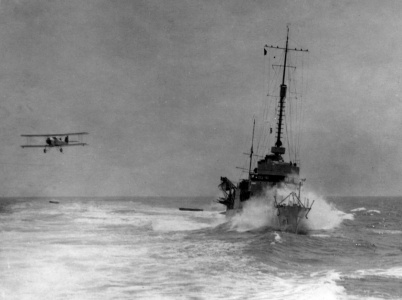USS Barker
Contents
Description
The USS Barker (DD-213) is a member of the Clemson-class destroyer family. The USS Barker was launched on September 11, 1919, by William Cramp & Sons in Philadelphia, and was sponsored by Mrs. Albert S. Barker, widow of Admiral Barker. It was commissioned on December 27, 1919. The USS Barker travelled to the Middle East in June 1920 to join Division 35, US Naval Detachment, Turkish Waters. She served with the American Relief of Armenia for many months and visited several ports in Turkey and the Middle East before going eastward to the Orient late in 1921 to begin her four-year tour of service with the Asiatic Fleet. In the early hours of December 11, 1937, the ocean liner SS President Hoover became stranded in a storm on Kasho-to, east of Formosa. The USS Barker was sent from Olongapo Naval Station to assist, while the USS Alden was sent from Manila. The USS Barker was at Tarakan, Borneo, on December 7, 1941, when it learnt the Pearl Harbor attack and promptly began patrolling the maritime area. She patrolled and escorted convoys in the Netherlands East Indies during the rest of December and into January 1942. The USS Barker performed two trans-Atlantic convoy escort crossings to England and four to North Africa between September 6, 1943, and October 1, 1944. The remainder of the USS Barker's active service was spent as a convoy escort in the Caribbean, Newfoundland, and along the U.S. eastern shore. She arrived in Philadelphia on June 4, 1945, was decommissioned on July 18, 1945, and sold on November 30, 1945.
Introduced in Update 1.79 "Project X", the USS Barker represents an improvement over previous Clemson-class destroyers. With two 20 mm Oerlikon Mark II anti-aircraft cannons, players may finally defend themselves against attacking aircraft. The firing angles are favourable, and the blind spots are subtle and difficult to exploit. However, this is still a very minimal threat to most planes and is ineffectual against planes beyond 1.5 km. As a result, finding a ship with greater anti-aircraft armament is critical. Overall, it is a well-rounded destroyer, with a large number of torpedoes, and good main armament accuracy. However, the firepower it possesses remains quite limited, relying primarily on the captain's skill to win against practically everything during battles. Thus, it is advised to avoid direct confrontations with other destroyers unless absolutely necessary.
General info
Survivability and armour
The Clemson class is lightly armoured and has an average crew size for a starter destroyer. The armour consists of 17 mm of steel on the hull and 10 mm of steel on the superstructure. At only 150 crew, the destroyer does not last long under fire, but the same can be said of the other starter destroyers. Additional armour is present on the gun mounts, but is otherwise absent. The Clemson class can endure against the smaller calibre guns found on torpedo boats and aircraft but is not able to stand up for long against other destroyers. There are some positives in the survivability, the guns are very hard to disable due to their small size and the layout having them spread out across the ship. 4 engines and 4 smoke stacks powering two transmissions makes it fairly hard to immobilise a Clemson. The fuel tanks are fairly small and only the rear ones are above the water line. The ammo racks are stored below the water line with the exception of the first stage, which are stored in the superstructure. The largest weak point is the bridge, which is very visible from all angles and very lightly protected.
Mobility
| Mobility Characteristics | |||||
|---|---|---|---|---|---|
| Game Mode | Upgrade Status | Maximum Speed (km/h) | Turn Time (s) | Turn Radius (m) | |
| Forward | Reverse | ||||
| AB | Stock | 58 | 19 | ~8.65 | ~15.68 |
| Upgraded | ___ | ___ | |||
| RB/SB | |||||
| Upgraded | ___ | ___ | |||
The Clemson's mobility and speed are nothing spectacular, it is actually quite slow among destroyers, but average for the starter destroyers. It is not exceptionally agile but is certainly capable of changing course to avoid torpedoes and high altitude bombs. The ability to change course abruptly will also help with overcoming the slow traverse of the primary armament.
Modifications and economy
Armament
Primary armament
The 102 mm primary armament of the Clemson class lacks firepower, but makes up for that with excellent accuracy. The HE ammo is the stock and best general use ammo, providing a decent amount of firepower but at the cost of being significantly less powerful than its 127 mm cousins. This should be used against virtually everything except heavily armoured targets. The APHEBC is ultimately not very useful, only seeing use against the rare BR 4.7 destroyer with actual armour, but those are rare and it will mostly see unarmoured targets where this shell struggles. It has no anti aircraft shells, but given the slow rate of fire and low angle of the guns, hitting aircraft is not in the mission description of this ship. Thankfully it is fairly good at hitting ships under 10 km with these guns, the accuracy allowing for ammo sniping with APHEBC or precisely disabling the guns of an enemy destroyer with HE. The velocity is quite good, making it a decent gun to learn destroyer combat on. But the lack of lethality from a low rate of fire and small calibre hold it back from being a good gun.
The layout of the Clemson is unconventional amongst destroyers. The forward gun is the most used one and can hit almost anything except targets immediately behind it. The midship starboard and port guns cannot aim fully forward but can aim forward enough that a target 30 degrees from the front of the ship could be targeted by these guns, but only one of the guns per side. The rear gun is the worst of the bunch, as it cannot rotate a full 360 degrees and instead must traverse all the way around the back of the ship in order to switch from shooting port to shooting starboard (and vice versa). This makes it rather challenging to adapt to new threats with the main guns, as you can only have 3 on target in a best case scenario but will usually be only able to use 1 or 2 of the guns. Couple with the low power of the guns, and it is not hard to see why the Clemson lacks in firepower compared to its contemporaries.
| Penetration statistics | |||||||
|---|---|---|---|---|---|---|---|
| Ammunition | Type of warhead |
Penetration @ 0° Angle of Attack (mm) | |||||
| 1,000 m | 2,500 m | 5,000 m | 7,500 m | 10,000 m | 15,000 m | ||
| HC Mk.15 | HE | 16 | 16 | 16 | 16 | 16 | 16 |
| SP Common | SP Common | 98 | 76 | 51 | 35 | 25 | 21 |
| HC Mk.15 (base fuse) | HE | 50 | 39 | 26 | 18 | 16 | 16 |
| Shell details | ||||||||||||
|---|---|---|---|---|---|---|---|---|---|---|---|---|
| Ammunition | Type of warhead |
Velocity (m/s) |
Projectile mass (kg) |
Fuse delay (s) |
Fuse sensitivity (mm) |
Explosive mass (TNT equivalent) (g) |
Ricochet | |||||
| 0% | 50% | 100% | ||||||||||
| HC Mk.15 | HE | 884 | 14.97 | 0 | 0.1 | 1,210 | 79° | 80° | 81° | |||
| SP Common | SP Common | 884 | 14.97 | 0.01 | 5 | 519.4 | 48° | 63° | 71° | |||
| HC Mk.15 (base fuse) | HE | 884 | 14.97 | 0.015 | 0.1 | 1,210 | 79° | 80° | 81° | |||
Secondary armament
The Clemson has only one secondary gun and most people tend to not notice it as it is very bad. While firing faster and traversing faster than the main guns, it can really only effectively fire towards the rear and is severely hampered by the velocity of the gun. There is an HE and an APHEBC ammo, but only the HE could be considered useful as the APHEBC has no desirable characteristics for an APHEBC shell, being slow and inaccurate with bad penetration. While intended to be used against aircraft, it was designed to be used against 1920s aircraft, which largely aren't even in the game to start with and the few that belong in that generation of aircraft are going to be very rare at its battle rating. Should you encounter a very large and slow flying biplane very low to the sea, this gun may prove itself useful.
| Penetration statistics | |||||||
|---|---|---|---|---|---|---|---|
| Ammunition | Type of warhead |
Penetration @ 0° Angle of Attack (mm) | |||||
| 100 m | 1,000 m | 2,000 m | 3,000 m | 4,000 m | 5,000 m | ||
| AA Mk.26 | HE-TF | 7 | 7 | 7 | 7 | 7 | 7 |
| Common Mk.3 | Common | 58 | 47 | 37 | 30 | 25 | 21 |
| Shell details | ||||||||||||
|---|---|---|---|---|---|---|---|---|---|---|---|---|
| Ammunition | Type of warhead |
Velocity (m/s) |
Projectile mass (kg) |
Fuse delay (m) |
Fuse sensitivity (mm) |
Explosive mass (TNT equivalent) (g) |
Ricochet | |||||
| 0% | 50% | 100% | ||||||||||
| AA Mk.26 | HE-TF | 503 | 5.9 | 0 | 0.1 | 340 | 79° | 80° | 81° | |||
| Common Mk.3 | Common | 503 | 5.9 | 1.6 | 8 | 62 | 47° | 60° | 65° | |||
Anti-aircraft armament
A tremendous improvement over its predecessor, this version of the Clemson class boasts 2 Oerlikon Mk.II 20 mm cannons. These are actually a threat to aircraft but the low amount of them make it a very weak threat to most planes and pilots. The 60 round drums and 4 second reloads mean it is possible to have downtime on the guns, which is less than ideal as aircraft are a credible threat to this ship. The firing angles are quite good and the blind spots are not very well known and somewhat hard to exploit. Finding a ship with better anti aircraft armament and sticking near them is still highly recommended as you have no long range air defence, the Oerlikons being limited to a maximum range of 2 km against surface targets and being largely ineffective against aircraft past 1.5km.
Additional armament
There are 4 torpedo launchers, 2 to each side, with 3 torpedoes per launcher. There are no extra torpedoes carried on board, but 12 is a respectable torpedo load nonetheless. The Mk.15 torpedo packs a pretty good punch, being capable of instantly hull breaking most ships in-game. The two torpedo modes allow you either range at the cost of speed (9.1 km at 62 km/h) or speed at the cost of range (5.5 km at 83 km/h). Because you cannot yet select which torpedo mode you desire in battle, you must pick this before you enter the battle, with the longer range mode being better in the Encounter game mode while the higher speed mode being generally more useful when ranges don't exceed 6 km.
Usage in battles
The Clemson is a very tedious ship to play, with its only advantages over other destroyers being its well rounded stats, high torpedo count, and good gun accuracy. Once it is required to fight higher rank destroyers, it suffers heavily and relies on its torpedoes in order to be useful. It can be used as a sniper with the HE, letting teammates fight with their better guns and armour while it uses superior accuracy to hit targets at ranges longer than expected for a gun of its calibre. While having some anti aircraft armament, it is still not sufficient to fight against the kind of aircraft common to its battle rating, meaning it is still going to suffer when enemy aircraft start to roam the skies. It is very weak in close quarters, relying heavily on the skill of the captain to get victories against almost everything at those ranges.
Generally speaking, avoid direct fights with anything more powerful than a sub chaser or torpedo boat. It can shine as a power house in a downtier, but once again it cannot effectively fight against its fellow starter destroyers (with the exception of other Clemsons), leaving it a subpar choice unless there are no better options available. A very good captain can make any ship effective, but for many captains the Clemson is a hard one to make work.
Pros and cons
Pros:
- Six torpedoes per side
- Turret traverse is decent compared to other first-generation destroyers
- Decent firing arcs
- Single 20 mm per side offers a minor degree of anti-aircraft protection
Cons:
- Slow shell velocity and rate of fire. This also makes aiming difficult at long ranges
- Extremely poor anti-aircraft protection. Single 20 mm is easy for enemy pilots to avoid
- No armour
- Firepower is woefully inadequate for dealing with later destroyers
History
Named after Rear Admiral Albert S. Barker, the USS Barker (DD-213) was a destroyer of the Clemson-class built for the American navy just after the end of World War 1. The ship was among the most advanced destroyers of its time when it was commissioned in 1919, and served extensively before the war in the Eastern theatre. Following the outbreak of war in the Pacific, Barker participated in some combat action in the Eastern theatre before being recalled to the Atlantic, where she served as an anti submarine ship until her decommissioning in 1945.
Design and development
The Clemson class was a large class of 156 destroyers built for the United States Navy (USN) just after the end of the First World War. Designed as a follow-up to the previous Wickes class, the ships were the last flush-decked destroyers built for the USN, in that their main deck was level throughout the entire ship. As well, they were the most numerous destroyers to serve in the USN until the introduction of the 175-ship Fletcher class during the Second World War. Barker was laid down on April 30th 1919 and eventually completed by December 27th of that year.
Barker displaced 1,215 tons and had a crew complement of 111 officers and men. Her main armament consisted of four 4-inch (100 mm) guns in single mounts, with one at the front, two on side sponsons and one aft. Her initial secondary armament consisted of three 3-inch (76 mm) guns in single mounts, intended for anti-aircraft defence. Finally, Barker carried twelve 21-inch (533 mm) torpedo tubes in four triple mounts, with six being able to fire to each side. Powered by geared turbines, the ship was capable of 35 knots (65 km/h).
Operational history
After her commissioning, the USS Barker was sent to the Middle East and visited some ports before being sent to the Asiatic fleet based in the Philippines. Barker remained in the area for two years before returning to the continental United States to serve two years with the Atlantic Scouting Force, followed by a deployment with the Fleet in Europe and visited numerous European ports. In August of 1929, Barker was redeployed to the Asiatic fleet, where she would stay until the outbreak of war.
At the time of the Pearl Harbour attack, Barker was at Tarakan, Borneo, and immediately started patrols to protect American shipping. She was involved escorting American transports in the Borneo area before returning to the continental United States for an overhaul in late 1942-early 1943. After her overhaul, the Barker was sent to the Atlantic, where she was active as a submarine hunter destroying U-Boats off of the American seaboard. She was responsible for rescuing survivors after submarines U-487, U-604 and U-185. After making two transatlantic convoy escort voyages, Barker was placed into reserve in mid-1945. She was sold for scrapping in November of that year, having accrued two battle stars for her WWII service.
Devblog
Laid down in April 1919, the USS Barker was part of the second production batch of the Clemson-class destroyers. She was completed by September of the same year and entered service with the U.S. Navy in December. In the interwar period, USS Barker visited several Turkish and Middle Eastern ports, before joining the Asiatic Fleet in the early 1920s. She cruised the Asiatic waters as well as performing patrols off the coast of Nicaragua before carrying out several visits to European ports in the late '20s. USS Barker was kept in the Asian theatre as part of the Asiatic Fleet until 1941, when the United States officially entered WW2 following the Pearl Harbour raid.
At the time of the raid on Pearl Harbour, USS Barker had been stationed on Borneo. Following the outbreak of hostilities between the U.S. and Japan, Barker undertook several patrol and escort missions around Borneo and the Dutch East Indies. Patrol and escort duties comprised most of USS Barker's routine whilst stationed in the Pacific. In 1943 however, USS Barker was assigned to the Atlantic theatre as part of a hunter killer group. Despite this, the USS Barker rarely engaged in direct combat. Instead, she's defined by her efforts of saving the lives of dozens of German sailors, who were lucky enough to survive the sinking of their vessel. From 1944 until the end of the war, Barker was mostly relegated to convoy escort duties in the Caribbean and Newfoundland. After the end of WW2, USS Barker was decommissioned and sold for scrap in November 1945, marking the end of her 26-year service period.
Media
- Skins
- Images
- Videos
See also
- Related development
External links
References
- Helgason, G. (1995). USS Barker. Retrieved January 26, 2021, from https://uboat.net/allies/warships/ship/2238.html
| William Cramp & Sons Shipbuilding Co. | |
|---|---|
| Gun Destroyers (DD) | |
| Clemson-class | USS Barker |
| Cruiser, Light (CL) | |
| Omaha-class | USS Trenton |
| Battleships (BB) | |
| Wyoming-class | USS Wyoming |
| USA destroyers | |
|---|---|
| Clemson-class | USS Welborn C. Wood · USS Barker · USS Litchfield |
| Farragut-class | USS Aylwin |
| Bagley-class | USS Bagley |
| Porter-class | USS Porter · USS Phelps · USS Moffett |
| Somers-class | USS Somers · USS Davis |
| Fletcher-class | USS Fletcher · USS Bennion · USS Cowell |
| Allen M. Sumner-class | USS Sumner |
| Gearing-class | USS Gearing · USS Frank Knox |
| Mitscher-class | USS Mitscher · USS Wilkinson |








